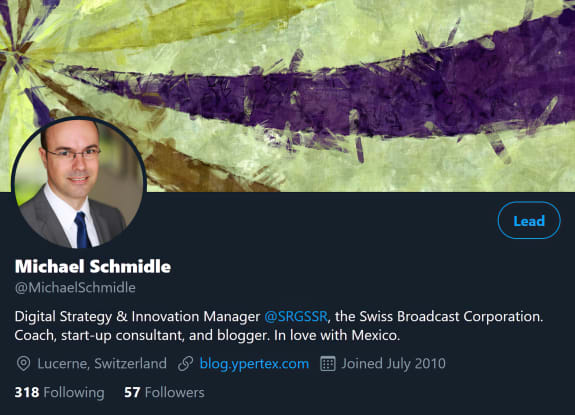Every leader follows something. The more they are conscious of what they follow, the better is their leadership. [Edited Jan 7, 2021]
There Are Those Who Follow—And Those Who Follow, Too ¶
If you think about it, you, me, and every other person on this planet is a follower.
You might follow an inspiring leader at work or in your community. You might follow a person who’s lived millennia ago or the person you’re married to. You might follow a grand idea or a certain vision of the future. You might follow the money or social status. Heck, you probably follow several people and several beliefs simultaneously! By the way: As we’ll learn in a moment, we primarily follow beliefs.

Some of these you follow just a small stretch of your journey, others you follow a lifetime.
The point is: Everybody is a follower. Without exception. This also includes people who most other people would regard as leaders. Which means: Leaders are followers, too. (Just look at the current POTUS, a role considered by many as the leader of western societies: Among other things, Donald Trump follows TV ratings.)
Leaders are followers who lead in addition to following.
What’s striking me is that, in most businesses today, it’s mostly ignored how followership and leadership work.
Followership is Taken, Leadership Is Given ¶
You as an individual decide who and what you want to follow. Of course, there are a lot of external factors who influence or manipulate you: your education, your peers’ opinion, social norms, marketing, etc.
In the end, however, it’s you who decides: If you wanted, it would be possible tomorrow for you to follow entirely other persons or things. Unfollowing
is a thing, and not just since Social Media exists.
Apropos Social Media: I haven’t come across a platform that has a Lead
button. And that makes total sense: I can’t dictate somebody else to follow me, can I?

Leadinstead of a
Followbutton. Weird, no? (Edited Jan 7, 2021: I left Twitter in the meantime.)
Yet, in most of today’s businesses, we do exactly that. Here’s your new boss. You’re expected to do what they say.
That’s hitting the Lead
button—dictating somebody else to follow another person. Haven’t we just concluded that this is nonsense? Exactly.
So who’d you pick as your boss if you could freely (un-) follow them? Who’d your chosen leader pick as their leader?
If you’re working in a hierarchical company, you can’t choose your boss. This is the case even in companies that are regarded as being extremely innovative. So we’ve started splitting the role into leaders and managers. Leaders inspire, managers administer. You’re lucky if your boss is both your leader and your manager. Otherwise, they’re just your manager.
Leadership is something that is given by followers only.
How Following Works ¶
Let’s take a moment to think about how we give others the privilege to lead us. What makes you follow somebody?
Is it the fact how many others follow them?
Picture these three random people:
- The prime minister of Baden-Württemberg, Germany’s third-largest state, asks you:
Hey, I’m elected leader of 11m inhabitants. Do you choose me as your leader, too?
- A stranger asks you:
Hey, I’ve 270k followers on Social Media. Want to follow me, too?
- Someone you just met asks you:
Hey, I’m leading a team of 20 people. Can I lead you, too?
You might be impressed by the numbers but they alone won’t make you follow anybody. I guess that’s not why we choose to follow someone. So what is it then? Here’s my answer:
What makes you follow somebody is what they are following. If someone shares the same vision and the same just cause as you and you believe that this someone incorporates your values best, then you follow.
In essence, you as one follower promote another follower of the same ideal to be your leader. You’re driven by the same cause.
Followers don’t show up for their leader, they show up for themselves.
Simon Sinek (adapted)
By the way, this also clears up an important detail: In reality, you never simply follow another person. First and foremost, you follow an idea, a vision, a cause—and secondarily a person who’s passionate about the same and who embodies it well.
Going back to Buddha and his followers: They’re not following primarily him as an individual but rather the values and the promise he represents.
The Clarity of Your Followership Impacts Your Leadership ¶
If you are a person in a leadership position, you can benefit a lot from reflecting on your followership first.

Ask yourself:
- What grand idea, what vision am I following as an individual?
- Do I express my passion for this vision enough with others—so that they can follow the same cause, together with me?
- Who else does this so well that I’m willing to follow this person as an embodiment of my idea and values?
- How much of that can I transfer to my leadership capabilities?
Being clear and conscious about your followership will have a profound impact on your leadership. As the title of this article says:
Conscious followers are better leaders.
Conclusion ¶
In this article, I took a closer look at what it means to be a better leader—and that it all starts with being clear about one’s followership:
- Everyone follows something
- Leadership can’t be taken but only be given
- Leaders are followed only because of what they follow themselves
Think about what ideas and values you follow. Express your passion for it. Observe what people do that you’d pick them as leaders in a heartbeat.
Try to be a conscious follower. It’ll make you a better leader.

Michael Schmidle
Founder of PrioMind. Start-up consultant, hobby music producer and blogger. Opinionated about technology, strategy, and leadership. In love with Mexico. This blog reflects my personal views.
Oct 6, 2024 · 4min read
Revolutionizing Decision-Making
Last year, I shared a simple framework for making better decisions. Little did I know it would spark a journey that led to creating PrioMind, an app that’s revolutionizing how we approach choices. Here’s the story of how four criteria evolved into a powerful decision-making tool, and what I’ve learned along the way. Continue…
Mar 5, 2023 · Oct 6, 2024 · 13min read
Four Criteria for Better Decision Making
While we all face decisions on a daily basis, we often reinvent the wheel in our process of decision making. However, there’s a set of strategic criteria that helps you making robust, fast, and comprehensible choices every time. Continue…
Jun 4, 2022 · 6min read
The Power of Subtractive Thinking
What’s better: more success or less failure? More possibilities or less impossibilities? Let’s take a look at the seemingly pointless question—and discover the surprising answer. Continue…
Feb 6, 2022 · 6min read
A Visualization of Leadership
Recently, I came across a helpful visualization of what Leadership means in times of Digital Transformation. Let me show you. Continue…



